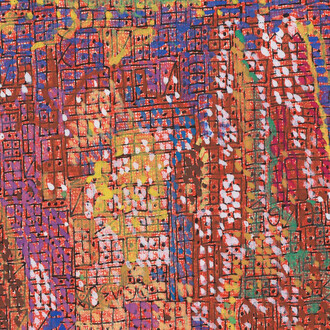The new paintings and sculptures that comprise this exhibition contain many of the features recognizable in Mark Hadjipateras’ practice: biosynthetic creatures, enigmatic objects and symbols, indeterminate topographies, and, of course, his characteristic playfulness. Here, however, it is as though a mist has lifted on the scenery revealing a brighter, fresher palette of clear blues and greys offset by acid yellows, greens, earth tones, accented with an occasional flash of red. Hadjipateras now presents a simpler world of more precisely executed forms that then transmigrate from their two-dimensional communities into discrete three-dimensional figures.
In the paintings, crisp bands of gradated or flat colour fields evoke curiously furnished rooms or horizon lines separating skies from uncharted seas and lands that support unidentifiable life forms. Unlike the populous stretches of Hadjipateras’ earlier Habitats, these places are sparsely settled. Each element plays a distinct role, albeit mystifying, in the environment. When the colour bands are vertical, they set up amicable if incongruent conversations between interior and exterior, among arabesques, swirls and static totems that could be of the natural world or of human production for domestic use, or some hybrid of both. Hadjipateras has removed illusory perspective but retained allusions to nature.
The cast aluminium sculptures take their forms from the paintings, in some cases directly and elsewhere less so. At 50cm tall, they are the comforting height of family pets. Like the shapes and creatures in the paintings, they conjure up plants, trees, lighting fixtures, furniture, marine life, birds, small predators, hieroglyphs, and obscure sacred objects. As autonomous and free-standing, unlike their two-dimensional counterparts, their presence and provenance is even more ambiguous.
Of the sculptures, some are given a shiny metallic finish; some are painted black and some are white. The metallic sculptures take mostly curvilinear and spiroid forms, whereas their black and white companions are generally more static. Although the modernist element has always been present in Hadjipateras’ practice, these graceful organic shapes are particularly informed by the 20th century sensibility shared with artists such as Arthur Dove, Joan Miró, Hans Arp, Henri Matisse, and others.















